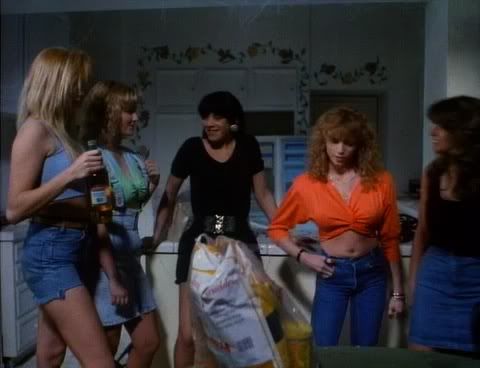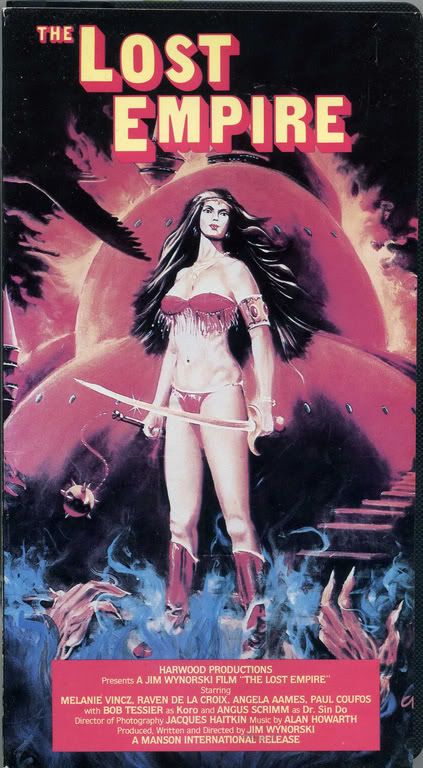The Wynorski Project Part Twelve - "976-EVIL II"
The Wynorski Project
Part Twelve
976-EVIL II
(1992)
Synopsis
Police think they’ve caught the serial killer responsible for at least 5 local murders, thanks to an eyewitness who saw a community college dean named Grubeck impale a buxom blond with a fake stalagmite (or stalactite? Google it yourself). Little do they know that Grubeck is in the thrall of Horrorscope, a supernatural phone service that bestows gifts upon its callers, so long as they are willing to make certain sacrifices. Thanks to Horrorscope, Grubeck is able to leave his body and escape the confines of jail, allowing him to continue his murder spree and pin his crimes on the lovely co-ed he lusts after. Minimal boobs are shed, stuff explodes and the power of evil is too strong to allow for a happy ending.
In Popatopolis, the documentary that helped inspire me to begin The Wynorski Project, there’s a moment where JW gives his documenters a tour of his house, which serves as a shrine to his decades in the film industry. His walls covered with posters from his past films, he points over to one of them and comments, “976-EVIL II, which I believe is even better than 976-EVIL 1.”
As this project continues, the central question that seems to keep popping up again and again is: Does Wynorski give a fuck? Is it he purely in it for the cash and tits, or does he actually aspire to create worthwhile cinema, but pretends not to because either A) he has never been given the opportunity to do so or B) he couldn’t even if he tried? Watching the films themselves, it would be easy to assume he is the epitome of the hacky opportunist who can’t be bothered with such a pretentious notion as “quality filmmaking”, but then in an interview or commentary you’ll hear him say something like the quote above and it becomes clear that the truth isn’t that cut and dried.
The fact that Wynorski is so quick to insist that a sequel he made to a terrible film no one cares about is better than the original is a sure sign that his seemingly dismissive attitude towards his own work shouldn’t be taken at face value. People, including the Jim Wynorskis of the world, are way more complicated than that.
I know this, because I have a surprisingly lot in common with Wynorski, beyond the obvious simularities found in our portliness, fondness for buxom women and facial hair.

To make up for my dissatisfaction, I would amuse myself by sneaking in sly jokes into the material, knowing 98% of my audience wouldn’t get them. The books were inevitably released without fanfare and the feedback I received from the public was minimal at best. If I did find a positive review/comment, chances were I’d soon find a negative one to counteract it. The young goth girl on MySpace who called Gothic Ghost Stories her favorite novel of all time was quickly canceled out by the Amazon.com reviewer who said the same book was uninspired and obviously written by a vocabulary-deprived narcissistic goth lesbian.
For the sake of my own sanity I had to pretend like I didn’t care. That I just wrote the books because it was my job and I had no interest in what happened to them after they were released. But, of course, I did care, because I knew that I was still trying to do the best I could under the circumstances. As much as I hated working on Ghost Stories of Missouri, I never wanted the people who bought it to feel the same way about reading it. It’s impossible for me to believe that anyone but a true sociopath can invest a part of their life into a project—no matter how pathetic or laughable—and not find themselves at least partially invested in it. Just as Wynorski clings to his belief that 976-EVIL II is better than 976-EVIL, I have to believe that my Campfire Ghost Stories II is better than Campfire Ghost Stories, even if no else is inclined to agree.
That said, is 976-EVIL II better than 976-EVIL?
Yes, but only because 976-EVIL is actually unwatchable, while Wynorski’s sequel is merely really, really boring. The original has the distinction of being the worst film ever written by a future Oscar winner (L.A. Confidential scribe Brian Helgeland), although I suspect most of the blame for the film’s failure has to go to first-time director Robert Englund, who proved that being a horror movie icon in front of the camera doesn’t necessarily translate to magic on the other side.
Ironically, in continuing the series Wynorski and his collaborators turn not to Englund’s film for inspiration, but to his most famous character instead—Grubeck here being a low-rent version of Freddy Krueger, which Wynorski cheerfully admits via a cheap one-liner.
While in the case of Chopping Mall he was at least semi-successful in combining horror with humour, here they just don’t mix. Instead of making the movie move more quickly along, the obvious “Wynorskian” one-liners only highlight how contrived and hokey everything else is. At its best 976-EVIL II plays like one of the worst episodes of Friday the 13th: The Series, without the charms of Louise Robey to make everything feel okay.
The film is especially hurt by the score of Chuck Cirano, whose work is often the best thing about Wynorski’s films, but in this case is way too old-fashioned to be effective. Instead of placing us in a modern horror film, it transports us to an earlier era in a way that distracts from what is going on onscreen.
Like the Nightmare on Elm Street series, there is some cleverness to be found amongst the mostly sucky bits—especially in a scene where a character is transported into a scene from It’s A Wonderful Life, only to have it transform into Night of the Living Dead (although I will admit I admired this more for the clever combination of two iconic public domain sources than its actual execution), but it’s not nearly enough to make the film worth sitting through.
Other reviewers might be tempted to praise the film’s dark ending, in which the heroine (whose tendency to pass out a lot seems directly tied to the tightness of her jeans) is unable to provide reasonable explanations for the supernatural events that have occurred and is arrested for murder, but I found it to be completely out of step with the film’s semi-jokey tone and another example—a la Sorority House Massacre II—of Wynorski sadistically punishing his final girl in the name of avoiding cliché (which would be a lot more acceptable if he didn’t embrace every other cliché in the book).
Beyond that, the only other thing I wanted to note is the fact that in this, her penultimate appearance in a Wynorski film, Monique Gabrielle plays a buttoned up D.A. whose entire performance is clearly dubbed in by another actress, which marks another indignity she can cross off her list.
Sadly, I have to report that next week marks the first instance of the Internet failing to provide me with a resource I require. Having exhausted every avenue I could think of that didn’t require the spending of actual money, I have failed to locate a copy of Munchie for review. For that reason I shall skip ahead to Sins of Desire and you’ll have to wait for my take on the whole Munchie-verse when I examine Munchie Strikes Back in Part Seventeen.
Next Week
Sins of Desire



























































































